HOMEDramafied Thinking Models Critical Thinking
Creative Thinking
Strategic Thinking
Symbolic Thinking Visual Learning Comics & Graphics
Videos & Film
Narrative Learning
Virtual LearningActive Learning Classrooms
Online & MOOC's
Virtual ImmersionInteractive Learning Mind Games
Games of Play
Writing Exercises
Self-Assessment Collaborative Learning
Peer Feedback
ESL Writing GroupsEdtech Industry Equity Partners
Procurement Into the FutureAbout the AuthorContact
- Dramafied Thinking
- Critical Thinking
- Creative Thinking
- Strategic Thinking
- Symbolic Thinking
Rarely do we find men who willingly engage in hard, solid thinking. There is an almost universal quest for easy answers and half-baked solutions. Nothing pains some people more than having to think. Wanna know what to think? No problem. Let others do your thinking for you. Wanna think for yourself? Learning how to think takes training and practice. The goal of Training of Thought is to help learners enhance their skills in seeking out new knowledge which they integrate into what they already know. They build confidence and conscience. Stories told through comics drive the content and validate the emotional challenges that come with venturing into the unknown; thus the use of the word “dramafied” for each thinking model. Learners bypass their natural resistance to moving beyond their comfort zone as part of developing thinking skills. Training of Thought is for high school and college students, as well as those in transition who may need extra support to assure success. However, any adult would benefit from its use. |
Infographics have a long tradition in all areas of education and are evolving into graphic wonders.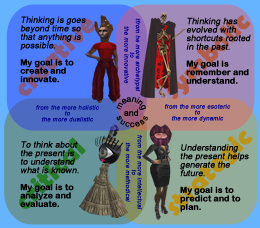
|
My mind seems to have become a kind of machine for grinding general laws out of large collections of facts. Critical thinking pushes learners beyond attitude and opinion so that they can better evaluate, associate and argue ideas. This requires more than logic. First learners make a claim. Then they research, collect data and analyzie that data before synthesizing that new information with what they already know to support their claim. Critical thinking is simply a process but requires training to develop the skills to work effectively. Although central to Common Core Standards, learners demonstrate disparate skills in critical thinking when they enter higher education. Training of Thought helps level the playing field and embraces cultural differences and differing language abilities. |
The Dramafied Web of Critical Thinking correlates with the construction of an essay.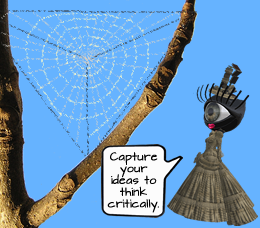
|
Not everyone see themselves as particularly creative, but anyone can develop creative thinking skills. Where creative thinking is concerned, that is the irony of the skill: the more adept you are at something, the less likely you are to look at it in a different way; the greater your skill of a particular discipline, the less you will be tempted to experiment with different approaches. Creative thinking asks learners to move beyond their comfort zone and explore new ideas that may change the way theiy see their world. They learn to make the abstract concrete and give shape to the amorphous. The Dramafied Spiral of Creative Thinking of Traininig of Thought is designed to help learners move through a layering process that is mental, emotional and even physical to develop creative thinking skills. With the help of Chaco, Penny moves through the Dramafied Spiral of Creative Thinking. Her process may appear linear, but she moves back and forth through the steps to assure success. |
The Dramafied Spiral correlates with story structure and character development.
|
There are people who are really good managers, people who can manage a big organization, and then there are people who are very analytic or focused on strategy. Those two types don't usually tend to be in the same person. I would put myself much more in the latter camp Strategic thinking is not easily defined, but relates to the understanding of systems and organizing principles, and is becoming a core competency in management. This type of thinking can be applied to anything from personal planning to organizational administration. The dramafied strategic thinking model, still in development, will use game theory to focus on effective planning tools for individuals working independently and in groups. Originally, game theory was a mathematical language that described how the strategic choices of a player affects the payoff of other players. However, it has also become tool for business development and marketing because it incorporates the psychological into planning to assure more accurate forecasting, sometimes through repetition as a way of developing skills. |
The foundation for dramafied strategic model will be game theory.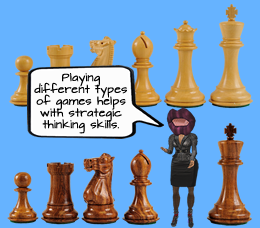
|
We live in a shortcut communication culture of emojis, acronyms, brands, icons, signs and other symbols. When a symbol is an archetype it evokes universal meanings and basic human experiences. In 1911, journalist Tess Flanders said: "A picture is worth a thousand words." A symbol is worth a million words and an archetype is priceless. Symbols are even more powerful when part of a symbolic language that merge symbols to better understand the human condition. They require heightened skills in abstract thinking and the ability to synthesize abstract concepts. As a result, interpretations vary based on the knowledge and experience of the user. Learning a symbolic language is a shortcut in enhancing all thinking abilities and inspires introspection and empathy when used as part of communication. Training of Thought is developing the dramafied model for symbolic thinking to capitalize on learners' curiosity about astrology, the Tarot or other symbolic languages. Aleister will help Penny use symbolic thinking to describe and understand herself and her world. |
The dramafied model of symbolic thinking only pretends to be magic. 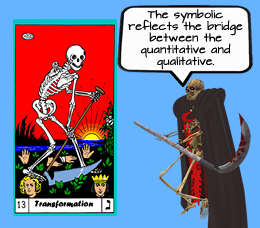
|
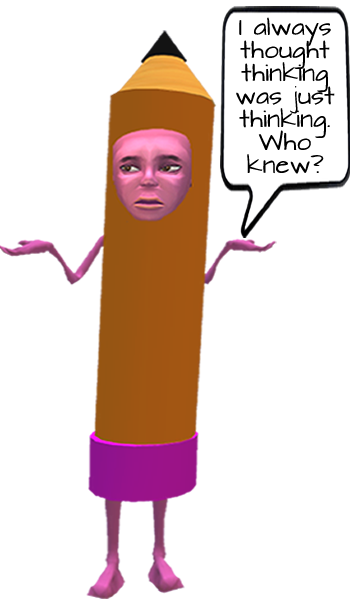
Visual Learning
Active Learning
Interactive Learning
Collaborative Learning
Edtech Industry
Into the Future
About the Author
Contact
